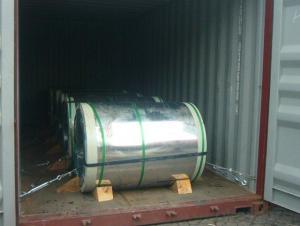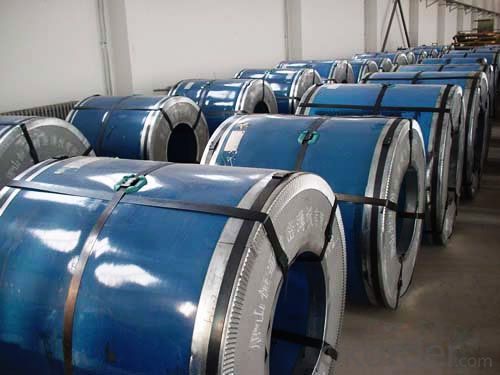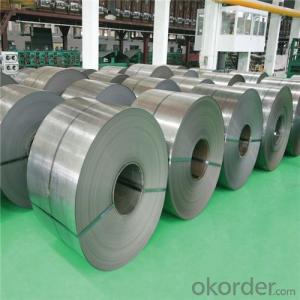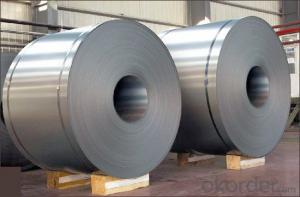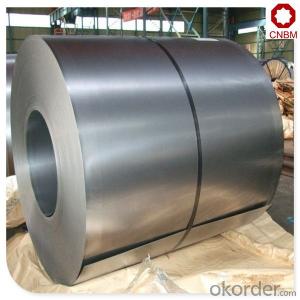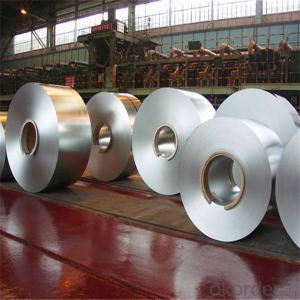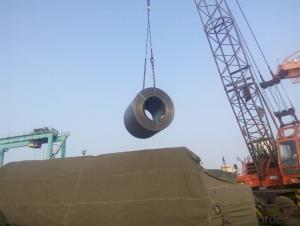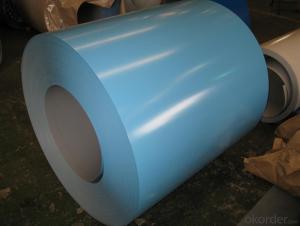Galvanized Steel Coil Prime Quality Hot sSale Zn 275 Low Price
- Loading Port:
- Tianjin
- Payment Terms:
- TT OR LC
- Min Order Qty:
- 10 m.t.
- Supply Capability:
- 10000000 m.t./month
OKorder Service Pledge
OKorder Financial Service
You Might Also Like
1.Description of Prepainted Galvanized Steel Coil and Color Coated Galvanized Steel Coil:
The galvanized steel coil that most construction workers use is often found in roofing applications. There, it is used as a protective cover or barrier over ridges and valleys in the roof system. The coil is rolled out flat on the roof, and bent either over the top of a ridge or into the crease in a valley, to protect the seam in the roof’s sheeting from exposure to the elements. It also creates a watershed for the runoff of rain and melting snow or ice.
2.Specifications of Prepainted Galvanized Steel Coil and Color Coated Galvanized Steel Coil:
Surface type: Normal spangle, min-spangle, free-spangle;
Surface treatment: chromated, unoiled/oiled, bright finished.
Main Usage : General use for Roof, Corrugated roofing making, The outside of buildings, Structures, Tile row plates, Deep drawing and deep drawn,etc
3.Prepainted Galvanized Steel Coil and Color Coated Galvanized Steel Coil Images:
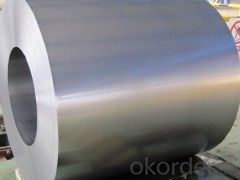
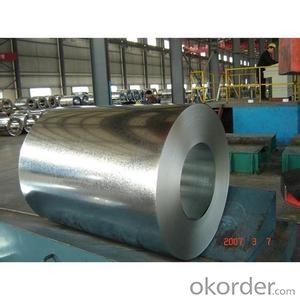
4.Prepainted Galvanized Steel Coil and Color Coated Galvanized Steel Coil Specification:
Standard: AISI, ASTM, BS, DIN, GB, JIS | Steel Grade: Q195-Q235 | Thickness: 0.20mm-3.0mm |
| Place of Origin: Hebei China (Mainland) | Technique: Cold Rolled | Surface Treatment: Galvanized |
| Application: drywall studs,ceiling bars.pipe et... | Model Number: WL-400 | Brand Name: Sanli |
| Width: 32-680 mm | Length: 187m-4549m | WL05: GI strip50 |
5.PACKING:
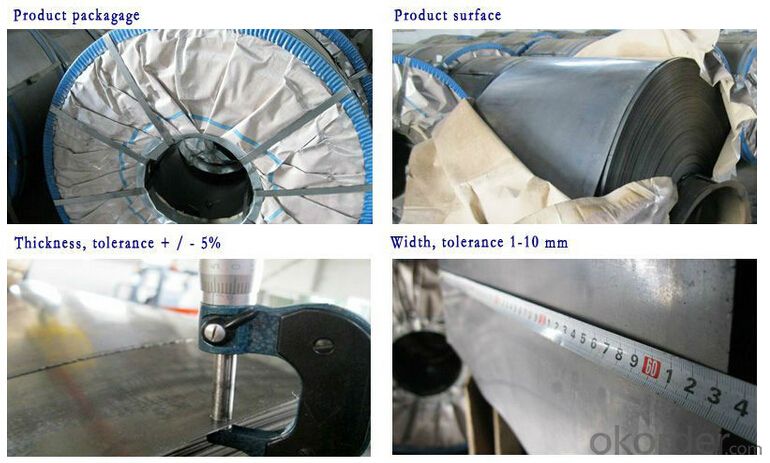
6.FAQ
We have organized several common questions for our clients,may help you sincerely:
①How about your company?
A world class manufacturer & supplier of castings forging in carbon steel and alloy steel,is one of the large-scale professional investment casting production bases in China,consisting of both casting foundry forging and machining factory. Annually more than 8000 tons Precision casting and forging parts are exported to markets in Europe,America and Japan. OEM casting and forging service available according to customer’s requirement.
②How to guarantee the quality of the products?
We have established the international advanced quality management system,every link from raw material to final product we have strict quality test;We resolutely put an end to unqualified products flowing into the market. At the same time, we will provide necessary follow-up service assurance.
③How long can we receive the product after purchase?
In the purchase of product within three working days, We will arrange the factory delivery as soon as possible. The pecific time of receiving is related to the state and position of customers.Commonly 7 to 10 working days can be served.
- Q: I'm looking to buy the Milano Stiletto, and it uses 1045 steel. I was just wondering whether this will hold up and keep an edge.
- Unfortunately, okorder /
- Q: How do you calculate the weight of a steel coil?
- In order to determine the weight of a steel coil, one must have knowledge of its dimensions and the specific gravity of the steel. The weight can be calculated using the following formula: Weight of steel coil = Length of coil (in meters) x Width of coil (in meters) x Thickness of coil (in meters) x Specific gravity of steel To begin, measure the length, width, and thickness of the steel coil in meters. It is important to ensure that all measurements are in the same unit in order to obtain accurate calculations. Next, find the specific gravity of the steel. The specific gravity is the ratio of the density of the substance to the density of water. For steel, the specific gravity is typically around 7.8. Multiply the length, width, and thickness of the coil together. This calculation will provide the volume of the steel coil in cubic meters. Lastly, multiply the volume of the coil by the specific gravity of steel to obtain the weight of the steel coil in kilograms (kg). Please note that this calculation only accounts for the weight of the steel coil and does not consider any additional factors such as the core material or any other components included in the coil.
- Q: How are steel coils used in the manufacturing of engine components?
- Steel coils are used in the manufacturing of engine components as they provide a reliable and sturdy base material. These coils are often shaped, cut, and formed into various engine parts such as pistons, crankshafts, and connecting rods. The strength and durability of steel make it ideal for withstanding the extreme temperatures and stresses that engine components endure during operation.
- Q: How do steel coils contribute to structural integrity in buildings?
- The role of steel coils in ensuring the structural integrity of buildings cannot be overstated. They play a vital role in multiple ways. To begin with, steel coils are extensively utilized in the construction industry to manufacture essential building components like beams, columns, and trusses. These components are responsible for providing support and stability to the overall structure. Due to their exceptional tensile strength and durability, steel coils guarantee that these components can withstand heavy loads and maintain their structural integrity over an extended period. This is particularly crucial in buildings with multiple floors or large open spaces, where the structural elements need to bear substantial weight without deforming or collapsing. Moreover, steel coils are also instrumental in reinforcing concrete structures. Reinforced concrete is a widely adopted construction technique, and steel coils, in the form of reinforcement bars or mesh, are embedded within the concrete to counteract tensile forces. While concrete excels at withstanding compressive forces, it is weak in tension. By incorporating steel coils, the composite material gains the ability to resist both compression and tension, thereby enhancing its structural integrity. This reinforcement technique is particularly vital in high-rise buildings or structures subject to seismic activity, where the risk of structural failure due to bending or cracking is heightened. Another significant contribution of steel coils to structural integrity lies in their corrosion resistance properties. Steel coils are often coated with protective layers, such as zinc through galvanization or paint, to prevent corrosion caused by moisture, chemicals, or environmental factors. Corrosion weakens the structural integrity of steel, leading to degradation and potential failure. By utilizing corrosion-resistant steel coils, the lifespan of the building is prolonged, and the risk of structural damage is significantly diminished. Furthermore, steel coils offer tremendous versatility in design and construction. Their flexibility and malleability allow for the creation of complex and intricate building structures, enabling architects and engineers to push the boundaries of design while maintaining structural integrity. Steel coils can be shaped, bent, and welded into various forms, making them an ideal material for constructing innovative and aesthetically pleasing buildings. In conclusion, steel coils are indispensable in ensuring the structural integrity of buildings. Their strength, stability, durability, corrosion resistance, and design versatility make them an essential material in modern construction, guaranteeing the safety and longevity of buildings for years to come.
- Q: Can steel coils be transported by air?
- Yes, steel coils can be transported by air. However, it is important to note that the size and weight of the coils may limit the type of aircraft that can be used for transportation. Additionally, special equipment and packaging may be required to ensure the safe and secure transport of the coils.
- Q: What are the different types of steel coil storage systems used during processing?
- There are several types of steel coil storage systems commonly used during processing, including coil racks, coil saddles, coil cradles, coil pads, and coil blocks. These systems are designed to safely store and handle steel coils, ensuring efficient processing operations and minimizing the risk of damage or accidents.
- Q: How are steel coils used in the production of shipping vessels?
- Steel coils serve as a crucial ingredient in the manufacturing of shipping vessels. Typically crafted from high-strength steel, these coils are ideal for fabricating the ships' hulls and other structural elements. In the shipbuilding process, the steel coils undergo an initial unrolling and cutting phase, where they are fashioned into specific sizes and shapes in accordance with the ship's design. These pre-cut pieces are then joined together through welding or bolting, forming the vessel's framework. This framework provides the necessary sturdiness and rigidity to withstand the unforgiving conditions of the sea. Additionally, steel coils are employed in the creation of decks, bulkheads, and various internal components of the shipping vessels. Molded into different sections, these coils are subsequently assembled and affixed to the ship's structure. The utilization of steel coils in these areas guarantees longevity and resistance to corrosion, which are vital for the overall durability and safety of the vessel. Moreover, steel coils find application in the production of ship propellers, rudders, and steering mechanisms. These components play an integral role in controlling the ship's movement and direction. The utilization of high-strength steel coils ensures the requisite robustness and dependability, facilitating smooth and efficient navigation. In summary, steel coils occupy a pivotal position in the manufacturing of shipping vessels. They provide strength, durability, and corrosion resistance, and are incorporated into various aspects of ship construction, ranging from the hull to the decks, bulkheads, and internal components. Absent steel coils, the production of shipping vessels would face significant challenges, resulting in ships lacking the necessary structural integrity to navigate the seas safely and efficiently.
- Q: What are the different types of steel coil handling attachments?
- There are several different types of steel coil handling attachments that are commonly used in industrial settings. These attachments are designed to safely and efficiently handle steel coils of various sizes and weights. One type of steel coil handling attachment is the coil lifter. This attachment is typically made of durable steel and is designed to securely grip the steel coil. It features a set of adjustable arms or hooks that can be positioned to fit the specific size and shape of the coil. Coil lifters are often used in conjunction with cranes or other lifting equipment to safely transport steel coils. Another common type of attachment is the coil grab. Similar to a coil lifter, a coil grab is used to securely grip and lift steel coils. However, coil grabs often feature a more compact design and are typically used in applications where space is limited. They can be operated manually or attached to a crane or forklift. Additionally, there are coil tongs that are specifically designed to handle smaller steel coils. These tongs are often used in manufacturing or processing facilities where coils need to be lifted and moved within a confined space. Coil tongs typically feature a set of adjustable jaws that can be positioned to grip the coil securely. In some cases, magnetic attachments are used to handle steel coils. These magnets are designed to attract and hold onto the steel, allowing for easy lifting and transportation. Magnetic attachments are often used in applications where other types of attachments may not be suitable, such as in environments with extreme temperatures or where the steel coils are coated. It is important to note that the specific type of steel coil handling attachment used will depend on the size and weight of the coils, as well as the specific requirements of the application. Industrial equipment suppliers can provide guidance on selecting the most appropriate attachment for a particular situation.
- Q: How are defects in steel coils detected and resolved?
- Defects in steel coils are detected through various methods such as visual inspection, ultrasonic testing, magnetic particle inspection, and eddy current testing. Once a defect is identified, it is resolved through processes like grinding, welding, or cutting out the affected area. In some cases, the entire coil may need to be rejected or sent for further processing to eliminate the defect.
Send your message to us
Galvanized Steel Coil Prime Quality Hot sSale Zn 275 Low Price
- Loading Port:
- Tianjin
- Payment Terms:
- TT OR LC
- Min Order Qty:
- 10 m.t.
- Supply Capability:
- 10000000 m.t./month
OKorder Service Pledge
OKorder Financial Service
Similar products
Hot products
Hot Searches
Related keywords
